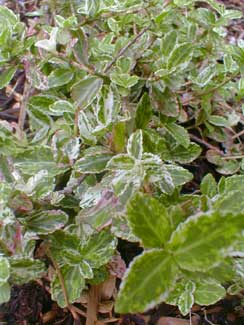
'Harlequin' Creeping Euonymus;
or, Variegated Wintercreeper
"With tears I watered love's creeper
and it took root."
-Mirabai
(1498-1546)
(1498-1546)
Euonymus fortunei var radicans 'Harlequin' is a dwarf evergreen creeping vine with variegated green & white leaves, with pink fall & winter highlights, for year-round interest. The oval leaves are littler & flatter than most varieties within this species. It was introduced by Brookside Gardens of Montgomery County, Maryland.
It is hardy in USDA zones 5 through 9. It spreads to three feet, further over time, but is a slow grower. It hugs the ground fairly closely, as short as three inches, possibly humping up to eight or ten inches after a great long while, although it can scrabble upward & over a rock or small trellis to two feet.
The species, native to China, can be aggressive in the garden & even invasive, but 'Harlequin' is extremely restrained. If used as a full groundcover, young plants would have to be as close together as one-foot & still take three years or longer to fill in completely, as the growth rate is even slower than for other slow-growing fortunei cultivars.
It does well in bright shade or partial shade, in well-draining soil. It is adaptable to more sun but like so many variegated plants would be at risk of sun-burn.
In conditions it dislikes it is susceptible to powdery mildew & attack by euonymus scale (Unaspis euonymi). A scale infestation can be very burdensome & difficult to control, though fortunately they tend to attack only stressed plants. A happy 'Harlequin' is low-maintenance & free of pests or disease.
Even maltreated, this plant can be hard to kill. When I first began doing gardening & landscaping at a certain property, I had to repair the damage done by a former owner who had the gardens very deeply way too mulched a year before. All of the low-growing 'Harlequin' patches were buried. Yet they worked their way to the surface of the woodchip mulch, brittle & scraggly, but alive. I dug them out, churned the soil for them, replanted them properly on the surface, & they bounced back to life.
Propagation is from late summer cuttings started in greenhouse or similar protection, or by root division in spring, or from self-rooted stems that have crept away from the central plant.